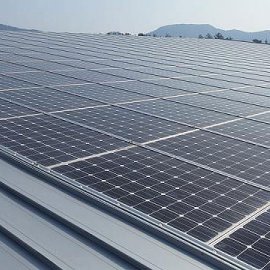Sunburst: The Power and Viability of Solar Energy
-
English
-
ListenPause
[intro music] Welcome to World Ocean Radio… I’m Peter Neill, Director of the World Ocean Observatory. My lifetime has seen the United States burst forward as a national economy and political leader beginning after the 2nd World War as a function of cheap energy generated by the burning of coal, then oil, then gas, a paradigm that fueled consumption and so-called progress worldwide. It is true that almost everyone on Earth benefited from this phenomenon, the making and distribution of goods and services that grew national productivity and employment. But that benefit clearly reached its limit when the consequences of that enterprise, evinced by CO2 emissions, acidification of land and sea, and the distribution of associated by-products as poisons and persistent pollutants, temperature rise, extreme weather, and all the other destruction phenomena we now attribute to changing climate and the deterioration of public health and security. Technology responded, with the invention of alternative ideas for new, less destructive energy production systems. And the market also responded, as investors and some corporations and some national governments assumed the responsibility for implementation through subsidy and direct action. It is not new news to understand this change, to see its advantage, and shift policy and finance in that direction. Solar energy generation has emerged as seriously viable, indeed advantageous alternative, and its implementation may be found in many places around the world. China has become a major true believer and has caused the construction of solar, along with wind and hydro-generation as alternative to its past dependence on coal and as concomitant driver of its rising standard of living and of its burgeoning population. The scale is enormous. According to Bloomberg News, the Chinese government will have reportedly invested more than $361 billion in this strategy and will have boosted its alternative capacity to over 20% by 2020. A Chinese private investment group is building what is purported to be the largest solar farm in the world, located in Nigxia Province, its 4 million panels covering over 4,600 hectares, roughly equivalent to 7000 US east coast city blocks, that will cost some $2.34 million and become the largest single production site in the world. In Ahnui Province, the Chinese took another significant step with the construction by Xinyi Solar of a floating solar farm, on a lake ironically over a collapsed coal mine, that can produce 40 megawatts of power, able to power 15,000 homes. There are certain advantages in building over such bodies of water, especially man-made lakes that are not ecologically sensitive, retain their reservoir capacity, provide cooling advantage for the solar electronics, and protect adjacent land for agricultural or other terrestrial use. For similar reasons, a floating plant was built in 2016 on Queen Elizabeth Reservoir near Heathrow Airport outside London to power the Thames Water Treatment Plant. We think mostly of water, and the ocean, as a dynamic system of biodiversity, and that is its largest intrinsic value. But it is also a surface, in these applications exemplified as a place which can support another, unexpected human need. It is also a reservoir of heat, again a function of solar collection and storage that can be transformed into an alternative energy system that does not pollute or poison, but could again be augmented by the physical motion of tide, wave, or current and transformed technologically into a desalination system then provides fresh water back into a supply hat has been otherwise corrupted by the old paradigm on land. There is here a circular system of energy exchange, an all natural cycle powered by the sun that must be welcomed, not denied by short-term indifference, that must be realized as sunburst, the most powerful opportunity available to us since the discovery of fire. These words, as they are written and broadcast, are the result of such a process – the twenty-four solar panels on my roof that power the means by which these thoughts are recorded and shared, and by the sun itself that illuminates where I, and all of us, live and love, work and grow. We will discuss these issues, and more, in future editions of World Ocean Radio. WORLD OCEAN RADIO IS DISTRIBUTED BY THE PUBLIC RADIO EXCHANGE AND THE PACIFICA NETWORK FOR USE BY COLLEGE AND COMMUNITY RADIO STATIONS WORLDWIDE. FIND US WHEREVER YOU LISTEN TO YOUR FAVORITE PODCASTS. [outro music]
Solar energy has emerged worldwide as a serious and viable alternative to fossil fuels, and can now be found in many places around the world. In this episode of World Ocean Radio we argue that solar power must be recognized as the most powerful energy technology available to us today.
Do you prefer the written word? Head on over to Medium.com/@TheW2O.
About World Ocean Radio
World Ocean Radio is a weekly series of five-minute audio essays available for syndicated use at no cost by college and community radio stations worldwide. Peter Neill, Director of the World Ocean Observatory and host of World Ocean Radio, provides coverage of a broad spectrum of ocean issues from science and education to advocacy and exemplary projects.
Resources from this Episode
- Bloomberg News: Chinese Government Solar Energy Strategy
- Xinyi Floating Solar Farm
- Solar: The Energy of the 21st Century
- Login to post comments



